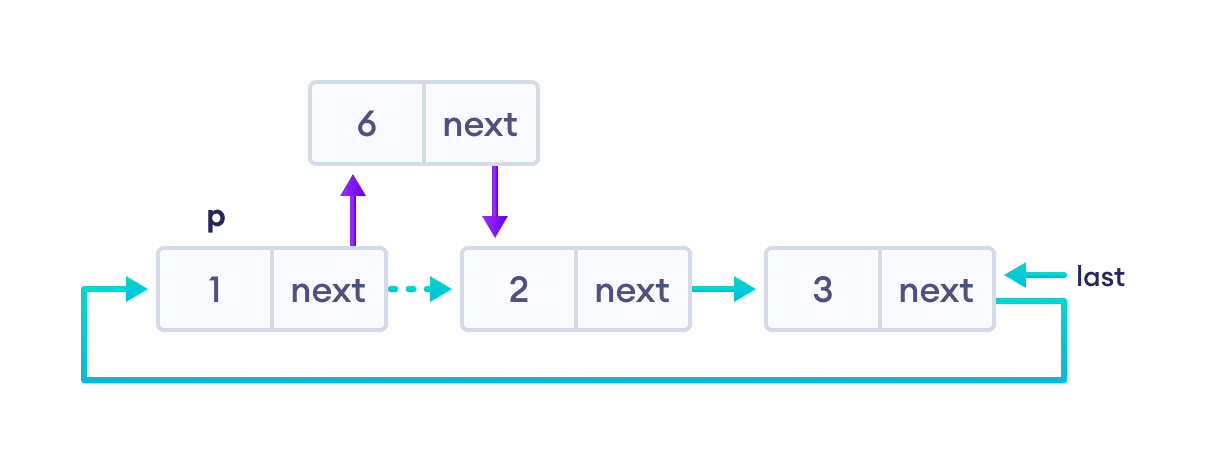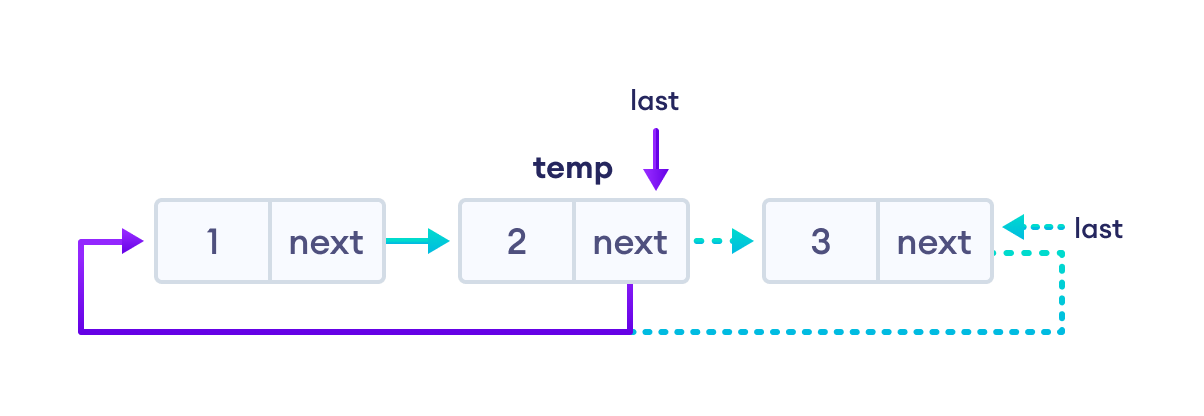In this article, you will learn what circular linked list is and its types with implementation.
A circular linked list is a type of linked list in which the first and the last nodes are also connected to each other to form a circle.
There are basically two types of circular linked list:
1. Circular Singly Linked List
Here, the address of the last node consists of the address of the first node.

2. Circular Doubly Linked List
Here, in addition to the last node storing the address of the first node, the first node will also store the address of the last node.

NOTE:< We will be using the singly circular linked list to represent the working of circular linked list.
Representation of Circular Linked List
Let's see how we can represent a circular linked list on an algorithm/code. Suppose we have a linked list:

Here, the single node is represented as
struct Node {
int data;
struct Node * next;
};
Each struct node has a data item and a pointer to the next struct node.
Now we will create a simple circular linked list with three items to understand how this works.
/* Initialize nodes */
struct node *last;
struct node *one = NULL;
struct node *two = NULL;
struct node *three = NULL;
/* Allocate memory */
one = malloc(sizeof(struct node));
two = malloc(sizeof(struct node));
three = malloc(sizeof(struct node));
/* Assign data values */
one->data = 1;
two->data = 2;
three->data = 3;
/* Connect nodes */
one->next = two;
two->next = three;
three->next = one;
/* Save address of third node in last */
last = three;
In the above code, one, two, and three are the nodes with data items 1, 2, and 3 respectively.
For node one
- next stores the address of two (there is no node before it)
For node two
- next stores the address of three
For node three
- next stores NULL (there is no node after it)
- next points to node one
Insertion on a Circular Linked List
We can insert elements at 3 different positions of a circular linked list
- Insertion at the beginning
- Insertion in-between nodes
- Insertion at the end
Suppose we have a circular linked list with elements 1, 2, and 3

Let's add a node with value 6 at different positions of the circular linked list we made above. The first step is to create a new node.
- allocate memory for newNode
- assign the data to newNode

1. Insertion at the Beginning
- store the address of the current first node in the newNode (i.e. pointing the newNode to the current first node)
- point the last node to newNode (i.e making newNode as head)

2. Insertion in between two nodes
Let's insert newNode after the first node.
- travel to the node given (let this node be p)
- point the next of newNode to the node next to p
- store the address of newNode at next of p

3. Insertion at the end
- store the address of the head node to next of newNode (making newNode the last node)
- point the current last node to newNode
- make newNode as the last node

Deletion on a Circular Linked List
Suppose we have a double-linked list with elements 1, 2, and 3.

1. If the node to be deleted is the only node
- free the memory occupied by the node
- store NULL in last
2. If last node is to be deleted
- find the node before the last node (let it be temp)
- store the address of the node next to the last node in temp
- free the memory of last
- make temp as the last node

3. If any other nodes are to be deleted
- travel to the node to be deleted (here we are deleting node 2)
- let the node before node 2 be temp
- store the address of the node next to 2 intemp
- free the memory of 2

Circular Linked List Code
// Java code to perform circular linked list operations
class CircularLinkedList {
static class Node {
int data;
Node next;
};
static Node addToEmpty(Node last, int data) {
if (last != null)
return last;
// allocate memory to the new node
Node newNode = new Node();
// assign data to the new node
newNode.data = data;
// assign last to newNode
last = newNode;
// create link to iteself
newNode.next = last;
return last;
}
// add node to the front
static Node addFront(Node last, int data) {
if (last == null)
return addToEmpty(last, data);
// allocate memory to the new node
Node newNode = new Node();
// add data to the node
newNode.data = data;
// store the address of the current first node in the newNode
newNode.next = last.next;
// make newNode as head
last.next = newNode;
return last;
}
// add node to the end
static Node addEnd(Node last, int data) {
if (last == null)
return addToEmpty(last, data);
// allocate memory to the new node
Node newNode = new Node();
// add data to the node
newNode.data = data;
// store the address of the head node to next of newNode
newNode.next = last.next;
// point the current last node to the newNode
last.next = newNode;
// make newNode as the last node
last = newNode;
return last;
}
static Node addAfter(Node last, int data, int item) {
if (last == null)
return null;
Node newNode, p;
p = last.next;
do {
// if the item is found, place newNode after it
if (p.data == item) {
// allocate memory to the new node
newNode = new Node();
// add data to the node
newNode.data = data;
// make the next of the current node as the next of newNode
newNode.next = p.next;
// put newNode to the next of p
p.next = newNode;
// if p is the last node, make newNode as the last node
if (p == last)
last = newNode;
return last;
}
p = p.next;
}
while (p != last.next);
System.out.println(item + "The given node is not present in the list");
return last;
}
// delete a node
static Node deleteNode(Node last, int key) {
// if linked list is empty
if (last == null)
return null;
// if the list contains only a single node
if (last.data == key && last.next == last) {
last = null;
return last;
}
Node temp = last, d = new Node();
// if last is to be deleted
if (last.data == key) {
// find the node before the last node
while (temp.next != last) {
temp = temp.next;
}
// point temp node to the next of last i.e. first node
temp.next = last.next;
last = temp.next;
}
// travel to the node to be deleted
while (temp.next != last && temp.next.data != key) {
temp = temp.next;
}
// if node to be deleted was found
if (temp.next.data == key) {
d = temp.next;
temp.next = d.next;
}
return last;
}
static void traverse(Node last) {
Node p;
if (last == null) {
System.out.println("List is empty.");
return;
}
p = last.next;
do {
System.out.print(p.data + " ");
p = p.next;
}
while (p != last.next);
}
public static void main(String[] args) {
Node last = null;
last = addToEmpty(last, 6);
last = addEnd(last, 8);
last = addFront(last, 2);
last = addAfter(last, 10, 2);
traverse(last);
deleteNode(last, 8);
traverse(last);
}
}
Circular Linked List Complexity
| Circular Linked List Complexity | Time Complexity | Space Complexity |
|---|---|---|
| Insertion Operation | O(1) or O(n) | O(1) |
| Deletion Operation | O(1) | O(1) |
1. Complexity of Insertion Operation
- The insertion operations that do not require traversal have the time complexity of O(1).
- And, an insertion that requires traversal has a time complexity of O(n).
- The space complexity is O(1)
2. Complexity of Deletion Operation
- All deletion operations run with a time complexity of O(1).
- And, the space complexity is O(1).
Why Circular Linked List?
- The NULL assignment is not required because a node always points to another node.
- The starting point can be set to any node.
- Traversal from the first node to the last node is quick.
Circular Linked List Applications
- It is used in multiplayer games to give a chance to each player to play the game.
- Multiple running applications can be placed in a circular linked list on an operating system. The os keeps on iterating over these applications.
to learn more go to the below mention link
Doubly Linked List Reverse of a linked ListHome